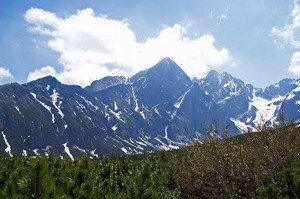The Tatras
The Tatras are the highest part of the Carpathian mountain range, and for centuries they were Poland’s natural border in the south. Arriving in Poland by air, the granite peaks rear up out of the clouds, slashing the skies like the claws of some mythic beast.
Traditionally, the lands beyond here belonged to Hungary, but by the mid-seventeenth century, the Ottoman Empire – Poland’s traditional foe – had crept all the way up to the Tatras. As the Sultan’s Empire crumbled, the Hungarians moved back in, and they enjoyed warm relations with the Poles. Today, it is the goodly Slovakians who live beyond the mountains, and border skirmishes are not likely to interfere with your hiking trips.

The Tatra mountains cover some 785 square kilometres, three quarters of which lie in Slovakia. The highest Polish peak is Mount Rysy, which rises to 2499 metres above sea level. However, the most distinctive peak is Giewont, which is known affectionately as the ‘Sleeping Knight’.
The Polish part of the Tatras was formally declared a national park in 1955. The lower and middle parts of the range are cloaked in forest. Beechs, which were traditional in this area, are now rarer, being superceded by larches, and above all spruces. These continue to grow beyond 1250 metres, along with stone pines, and it is in this area that wildlife is at its richest. Deer, wild boar, lynx, wolves and bears are to be found, as well as a great variety of birds and the Apollo butterfly.
Higher up, in the rockier areas, live the chamois and the alpine marmot and vole. The golden eagle is now very rare. However, as country dwellers know, it is quite likely that you won’t see any mammals at all, as they are shy of humanfolk. In this case you may have to make to do with the slightly surreal stuffed collection in the Tatra Museum.
There are rare types of flowers on the starker rock faces, but the richest flowers can be seen in the meadows and down in the valleys, where yellow crocuses form carpets in Spring. It is in the valleys too, that you can discover the caves. These are a very popular aspect of the Tatras, and steeped in legend. Much like the English band of Robin Hood, the region was once inhabited by outlaws – the famed ‘zbojnicki’. Seven caves are open to the public, six of which lie in the beautiful Koscieliska valley. Another popular feature of the range are the lakes, most famously the vast Morskie Oko, the ‘Eye of the Sea.’
For skiers, the Kasprowy Wierch Peak is serviced by cable-car, and there are chairlifts in the Goryczlowa and Gasienicowa valleys. For hikers, there are 250 kilometres of trails in the park, ranging from leisurely strolls to hair-raising ascents for serious climbers. Entrance to the valleys is possible by bus, but from there you must continue on foot to the heart of the Tatras. Mountain bikes are permitted only on a few paths. Owing to the unpredictability of Mother Nature, there are basic safety precautions which are essential to bear in mind.
With the collapse of the Iron Curtain, border relations are now freer than ever. Thus for dedicated hikers, the opportunity to explore the region in depth is very much an option. Poles are the first to say how wonderful the Slovakian Tatras are, and it’s well worth bearing this in mind if you want to get a full flavour of this wild region.
Awesome Childrens Reply
November 13, 2014 at 9:44 am
Thank you for the auspicious writeup. It in truth was once a enjoyment account it. Look advanced to more added agreeable from you! By the way, how can we keep in touch?